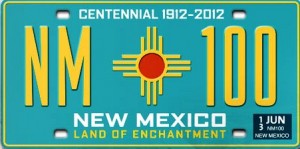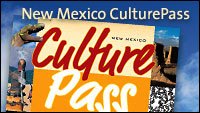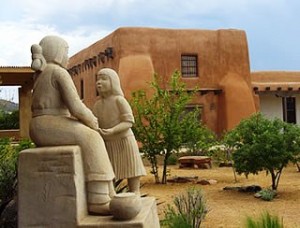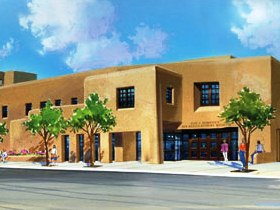» posted on Thursday, November 1st, 2012 by Linda Lou Burton
A Petri Dish of Culture
 Linda Burton posting from Santa Fe, New Mexico – Everybody loves a party, and there’s been a big one going on this year in New Mexico. It’s a Centennial year, celebrating New Mexico’s 100 years of statehood; on January 6, 1912 it became the 47th state. Festivals and events have been happening from one corner of the state to the other; there was even a Culture Pass for sale! It cost $25 and offered access to the 8 museums and 6 monuments that fall within the aegis of New Mexico’s Department of Cultural Affairs. http://www.newmexicoculture.org/index.php . This department, headquartered in Santa Fe, was created back in 1978 and, according to its website, is dedicated to “preserving and celebrating the cultural integrity and diversity of our state.” It oversees a broad range of New Mexico’s arts and cultural heritage agencies (15 divisions);
Linda Burton posting from Santa Fe, New Mexico – Everybody loves a party, and there’s been a big one going on this year in New Mexico. It’s a Centennial year, celebrating New Mexico’s 100 years of statehood; on January 6, 1912 it became the 47th state. Festivals and events have been happening from one corner of the state to the other; there was even a Culture Pass for sale! It cost $25 and offered access to the 8 museums and 6 monuments that fall within the aegis of New Mexico’s Department of Cultural Affairs. http://www.newmexicoculture.org/index.php . This department, headquartered in Santa Fe, was created back in 1978 and, according to its website, is dedicated to “preserving and celebrating the cultural integrity and diversity of our state.” It oversees a broad range of New Mexico’s arts and cultural heritage agencies (15 divisions);  there are 500 employees and about a thousand volunteers who put in 70,000 hours annually. Every year more than $2 million goes directly to New Mexico’s cultural activities to fund arts and cultural programs; over three million people are served. But back to that Culture Pass, and the doors it would open.
there are 500 employees and about a thousand volunteers who put in 70,000 hours annually. Every year more than $2 million goes directly to New Mexico’s cultural activities to fund arts and cultural programs; over three million people are served. But back to that Culture Pass, and the doors it would open.
Santa Fe — Museum of Indian Arts and Culture; Museum of International Folk Art; New Mexico History Museum/Palace of the Governors; New Mexico Museum of Art
Alamogordo — New Mexico Museum of Space History
Albuquerque — National Hispanic Cultural Center; New Mexico Museum of Natural History and Science
Las Cruces — New Mexico Farm & Ranch Heritage Museum
PLUS: The Bosque Redondo Memorial at Fort Sumner, Coronado State Monument in Sandoval, El Camino Real International Heritage Center in San Antonio, Fort Selden State Monument in Radium Springs, Jemez State Monument in Jemez Springs, and the Lincoln State Monument in Lincoln, NM.
That’s a real “petrie dish” of cultural opportunities; certainly more than I’ll be able to see during my visit; but I hope to explore the four that are here in Santa Fe.
Museum of Indian Arts & Culture at 710 Camino Lejo off Old Santa Fe Trail, 505.476.1250, http://www.indianartsandculture.org/history
 Here’s where you’ll find Native art and learn the stories of Southwest people through contemporary art. From their website: Anthropologist Edgar Lee Hewett founded the Museum of New Mexico in 1909 with a mission to collect and preserve Southwest Native American material culture. In 1927, John D. Rockefeller founded the renowned Laboratory of Anthropology with a mission to study the Southwest’s indigenous cultures. In 1947 the two institutions merged, bringing together the most inclusive and systematically acquired collection of New Mexican and Southwestern anthropological artifacts in the country. The exhibition “Here, Now & Always” incorporates the voices of more than 75 Native Americans and tells the rich, complex and diverse stories of Native Americans in the Southwest through their own words and some 1,300 objects drawn from the Museum’s collections.
Here’s where you’ll find Native art and learn the stories of Southwest people through contemporary art. From their website: Anthropologist Edgar Lee Hewett founded the Museum of New Mexico in 1909 with a mission to collect and preserve Southwest Native American material culture. In 1927, John D. Rockefeller founded the renowned Laboratory of Anthropology with a mission to study the Southwest’s indigenous cultures. In 1947 the two institutions merged, bringing together the most inclusive and systematically acquired collection of New Mexican and Southwestern anthropological artifacts in the country. The exhibition “Here, Now & Always” incorporates the voices of more than 75 Native Americans and tells the rich, complex and diverse stories of Native Americans in the Southwest through their own words and some 1,300 objects drawn from the Museum’s collections.
Museum of International Folk Art on Camino Lejo off Old Santa Fe Trail, 505.476.1200, http://www.internationalfolkart.org/
 The Museum of International Folk Art is home to the world’s largest collection of folk art. From their website: More than 135,000 artifacts form the basis for exhibitions in four distinct wings. In 2003, the Museum celebrated 50 years of documenting, collecting, preserving and interpreting the creative works of traditional artists from cultures around the world. It was founded by Florence Dibell Bartlett who believed that encouraging people to interact with folk art and with one another would help promote cultural understanding.
The Museum of International Folk Art is home to the world’s largest collection of folk art. From their website: More than 135,000 artifacts form the basis for exhibitions in four distinct wings. In 2003, the Museum celebrated 50 years of documenting, collecting, preserving and interpreting the creative works of traditional artists from cultures around the world. It was founded by Florence Dibell Bartlett who believed that encouraging people to interact with folk art and with one another would help promote cultural understanding.
New Mexico History Museum/Palace of the Governors, On the Historic Plaza, 113 Lincoln Avenue, 505.476.5200, http://www.nmhistorymuseum.org/ and http://www.palaceofthegovernors.org/index.php
 The New Mexico History Museum began as a storage facility for collections at the Palace of the Governors decades ago and has evolved into a first-class museum. From their website: History museums are no longer attics or basements full of long-forgotten objects. They are now places that partner in education, civic engagement, and social change. The Palace of Governors was originally constructed in the early 17th century as Spain’s seat of government for what is today the American Southwest. This adobe structure is now the state’s history museum, chronicling the history of Santa Fe, New Mexico, and the Region. It is a National Historic Landmark and an American Treasure.
The New Mexico History Museum began as a storage facility for collections at the Palace of the Governors decades ago and has evolved into a first-class museum. From their website: History museums are no longer attics or basements full of long-forgotten objects. They are now places that partner in education, civic engagement, and social change. The Palace of Governors was originally constructed in the early 17th century as Spain’s seat of government for what is today the American Southwest. This adobe structure is now the state’s history museum, chronicling the history of Santa Fe, New Mexico, and the Region. It is a National Historic Landmark and an American Treasure.
New Mexico Museum of Art, 107 West Palace Avenue, 505.476.5072, http://www.nmartmuseum.org/
 This museum traces art in the American Southwest from the earliest Clovis culture to the present. From their website: The New Mexico Museum of Art began in 1917 as the Art Gallery for the Museum of New Mexico that was then located in the Palace of the Governors. The “It’s About Time” exhibit emphasizes the prime objects of artistic change as part of the centennial celebration of New Mexico statehood.
This museum traces art in the American Southwest from the earliest Clovis culture to the present. From their website: The New Mexico Museum of Art began in 1917 as the Art Gallery for the Museum of New Mexico that was then located in the Palace of the Governors. The “It’s About Time” exhibit emphasizes the prime objects of artistic change as part of the centennial celebration of New Mexico statehood.

